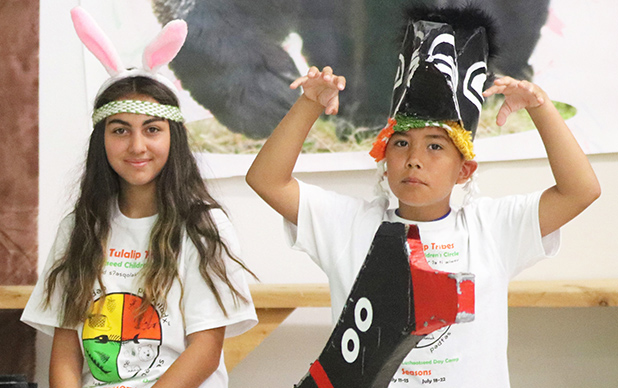
By Micheal Rios, Tulalip News
Lushootseed, ancestral language of the modern day Tulalip Tribes, was the supreme language of the land seven generations ago. From the Salish Sea to the Cascade Mountains, from the Nisqually River to Vancouver Island, tribes of the plentiful Pacific Northwest shared a common tongue. Then arrived colonization. Followed by assimilation.
The shared language of the Coast Salish people nearly vanished after decades of brutal treatment inflicted upon generation after generation by the U.S. government and its various forms of enforcement police after the Treaty of Point Elliot was signed. ‘Kill the Indian, save the man’ was the name of the game, and the colonizers played it well.
Various laws and federally enforced policies, such as the Indian Removal Act (1830), Religious Crimes Code (1883) and General Allotment Act (1887), intentionally sought to to strip Native people of their culture and connection to place. It can be argued the most successful part of the assimilation process was boarding schools because the innocent children forced to attend couldn’t defend themselves. Their hair was cut to military standards, their traditional clothes replaced with church designed uniforms, and in horrific fashion they were helpless as they watched classmates beaten for speaking Lushootseed.
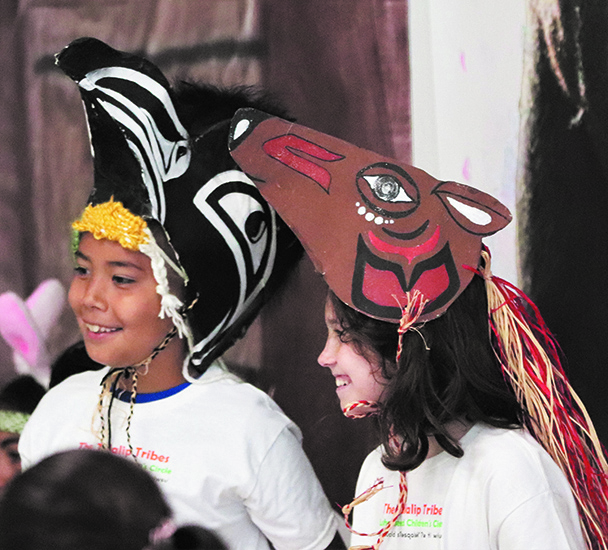
In the Declaration of Independence, we are referred to as merciless Indian savages. The use of merciless couldn’t have been more accurate as it foreshadowed a determination and sheer force of will to survive. Yes, colonization happened. Yes, assimilation was effective. However, it can’t be overlooked or understated that our ancestors survived. They were in fact merciless. If they weren’t then we wouldn’t exist today; part of a thriving tribal ecosystem consisting of 574 federally recognized tribes.
Within that thriving tribal ecosystem exists the Tulalip Tribes’ Lushootseed department tasked with increasing awareness of Lushootseed within the community and beyond, as well as restoring the language to everyday use. This is a colossal undertaking, but one intending to make the ancestors proud. Proud that generational healing is taking place on the same grounds where missionaries and government officials inflicted so much harm. Proud that the same Lushootseed language they were punished, beaten and even jailed for having the audacity to speak while attending boarding school is spoken today by our own culture bearing educators and their spirited students.
At the 25th annual Lushootseed language camp, which took place from July 11 to July 22 at the Kenny Moses Building, over 120 Tulalip youth became an integral part of Lushootseed revival. Led by our own committed crew of language warriors and their support staff, the children participated in eight different daily activities: technology, weaving, art, play, songs, traditional teachings, games, and play. In doing so, Tulalip’s next generation embraced their culture while learning vital traditional teachings, stories, and, most importantly, the language of their ancestors.
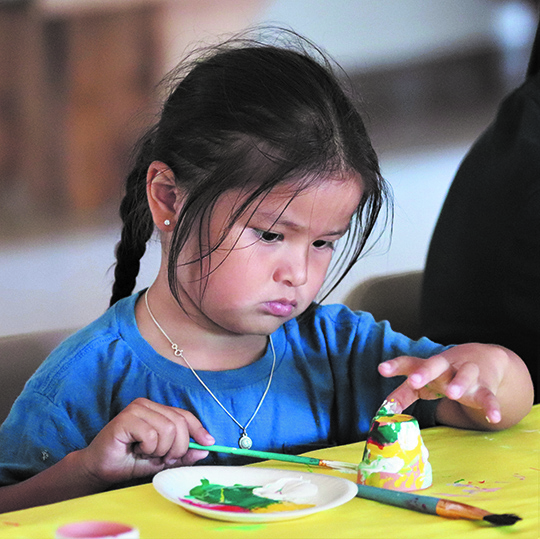
The photos accompanying this article illustrate Tulalip pride and a strength of culture as only our beautiful children can elegantly emit while participating in the annual Lushootseed camp. However, it’s in the words and background stories of their fully self-aware educators where we can grasp what it takes to create such a Lushootseed-rich environment. Educators like Tulalip’s own Sarah Miller, Nik-ko-te “Nikki” Oldham, and their tech guru Dave Sienko have dedicated their livelihoods towards a dream of Lushootseed being spoke at work, in schools, and in the homes of every Tulalip family.
Sarah Miller
“I became interested in Lushootseed when I was about 15-years-old, when I took a Lushootseed class taught by Toby Langen and Tony Hatch at Pilchuck High School. I had a great time learning and it’s one of my fondest memories of high school. I enjoyed speaking the language and wanted to do more with it, but at the time didn’t know what more I could do. So there was a many-year gap in my language learning.
Nearly ten years ago, I decided to switch jobs from the newspaper to the language department. I took college level Lushootseed and started teaching preschool kids. It was fun teaching the kids. Eventually I worked my way up to teaching the college level Lushootseed classes, and in doing that, I began to understand the language even more. It is a passion for me. I take every opportunity I can to use the language and to teach it to others.
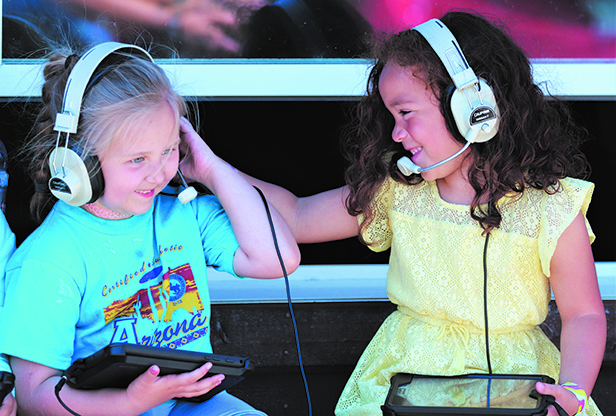
At this year’s 25th annual Lushootseed camp, my station is Language. Our theme is seasons, so my partner Michelle Schmaus and I teach the kids about the various seasons using Lushootseed. After that, we have the kids decorate the season tree with leaves, snowflakes or flowers, depending on the season. I hope the kids take away from this experience how our ancestors used to live from season to season. I want them to understand that we used to live off the land and the land had everything we needed to survive from season to season.
What I look forward to most about camp is the kids developing a passion and interest in their ancestral tongue. I hope they walk away understanding more about what it means to be Indigenous. I look forward to them taking what they’ve learned home to their families and sharing it. This is how we keep our culture alive.
Camp time is a wonderful but stressful time because we only get one week with the kids. It’s kind of a rush to teach the kids as much as we can and hope that some of it sticks. I hope the experience is nourishing to their spirits and they will be eager to learn more.
In the future, I’d love to incorporate families into the camp element so the parents can learn their language alongside their children. I think it would strengthen relationships and bonds and further our mission to keep the language alive.”
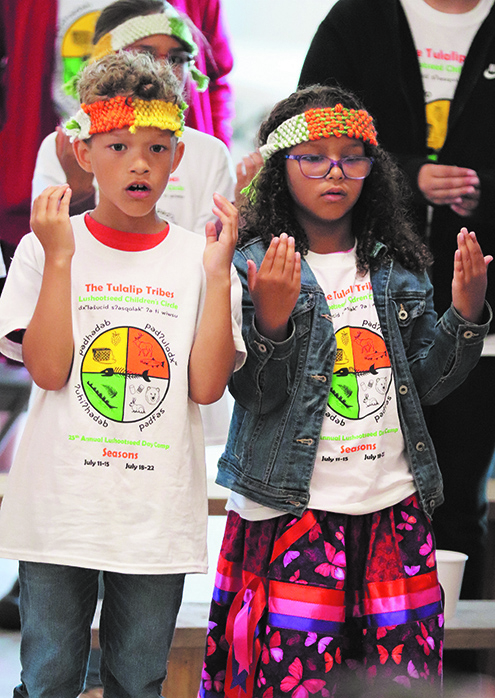
Nik-ko-te “Nikki” Oldham
“My background with language is a sort of unique because I grew up hearing both Lushootseed and Absentee Shawnee words and phrases spoken by my great grandma, grandparents, aunts, uncles and mom.
- What time is it? – ʔaləxʷ k̓ʷid
- Be quiet – x̌ʷubiləxʷ
- Sit down – gʷədil
- No – x̌ʷiʔ
- Drink – sqʷuʔqʷaʔ
- Knock it off – gʷəƛ̕əlad
- Dog – sqʷəbayʔ
- Cat – pišpiš
- Frog – waq̓waq̓
- Eagle – yəx̌ʷəlaʔ
- Deer – sqigʷəc
- Crap – sp̓əc
These were common words to me at a young age. I have always loved the language, but I became very inspired learning that my great grandma Marya was one of the last fluent speakers.
At this year’s camp, I am managing the weaving station with Jasmyne Diaz. We are teaching the kids to make wool headbands. I hope they learn to never give up, that it’s ok to mess up and start over because that’s the basis for all learning, and the more you practice, the better you get. I also want them to learn our tradition of giving away an item that you made for the first time.
I look forward to seeing everything that the kids create. It’s difficult to describe hearing them speak the language and understand new words, especially for first timers. It makes my heart so happy to see the kids do the closing ceremony play and hear them speak the language. Being a Lushootseed teacher isn’t always easy, but hearing the kids speak the language of those who came before them makes it all worth it.”
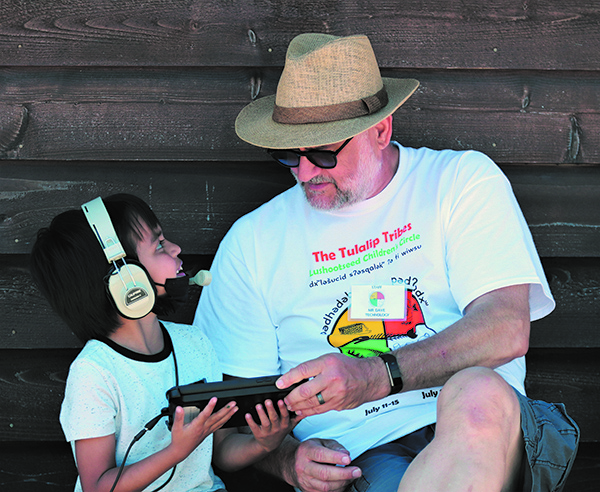
Dave Sienko
“I’m just a cog in the team, trying to increase the learning and use of dxʷləšucid. I started in the department 17 years ago when the need was creating resources beyond the archive recordings made by Thom Hess and Leon Metcalf. We started making CDs and then video recordings of elders. Then we focused on creating our Tulalip Lushootseed website was the next thing we created. Trying to increase the number of language resources available to the community is a key need the department focuses on.
The biggest challenges over the years has really been the rapidly changing technologies. It’s always a challenge to stay current.
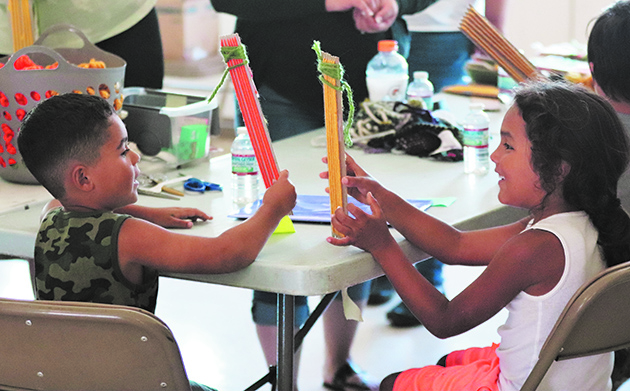
At language camp, I always run the technology station. When I first started, we used older computers, then Nintendo DSi’s, and now we use Samsung tablets. The kids can use a variety of language apps, including the Lushootseed Alphabet app, Lushootseed Phrases, and Word Quizzes, as well as Our Table, a family orientated Language App. Teachers from different stations tell me what they are doing and I try to develop material that focuses on these key items.
Preserving and encouraging the use of the language is one of the most important things about the work we do, and it’s one of the reasons I took the job at Tulalip. I really enjoy working with the younger kids because of their high level of enthusiasm. There are always several camp participants that we witness their growth in the language surge over the week.
For the teachers and camp staff, this is also an opportunity to create or nurture bonds the kids that can last a lifetime. Watching the youth develop that spark of excitement in speaking dxʷləšucid clearly brings so much joy to not just me, but our teachers and the families as well. When young tribal members grasp the language early, they can develop a happiness and strength from their cultural self-confidence that is truly awe-inspiring. I’m humbled to be a part of this.”
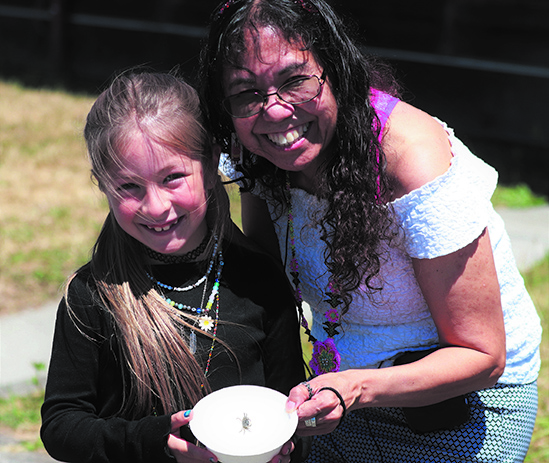
The Lushootseed department has so many resources available for our people who desire to learn their ancestral language beyond the annual youth camp. Their website tulaliplushootseed.com offers videos, common words and phrases, and all sorts of traditional stories told in Lushootseed with accompanying text to follow along. If you’re a more hands-on learner, then Lushootseed staff would remind you that they offer classes through NWIC and community outreach programs.
Lastly, tribal members are always welcome to stop by the Lushootseed department and ask for hard copies of work books, CDs and various learning materials intended for beginners. It’s never too late to join in on the language warriors’ mission and make your ancestors proud by speaking the same words, in the same syllables they once did.